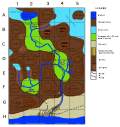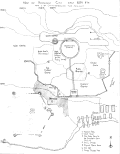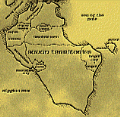Rephidim is arguably the most important location on Sinai, whether one is talking about the sky island called Rephidim, or the city of the same name built on one side of it. (Some also call the mountain in its center "Mount Rephidim".)
4.1.1 Rephidim: The Island
Rephidim is the only sky island known to be significantly inhabited. A
trading city of 50,000 sprawls over the mountainous surface, ruled
from the Temple by the Captain-Astromancer and a religious bureaucracy
that seems to exist to confuse and impress unwary visitors. The people
of Rephidim are merchants, artisans and mechanics, scholars and poets,
immigrants and con artists. They are adventurous, curious, and
renowned for haggling over every shekel spent or earned. Rephidim
depends on the surface nations for food, in exchange for which it
doles out knowledge and mediates treaties and trade agreements.
One phenomenon most prominent in the floating island known as Rephidim, among
all floating islands which have been studied, concerns a localized
change in air pressure and temperature. This has the general effect of
making the temperature and air pressure stay within fairly steady
ranges comparable to that at ground level, though far more uniform. It
has been theorized that this may be yet another legacy of the First
Ones, perhaps tied to the unknown means which allow the island to
float in the first place.
One side effect of this phenomenon is that there are disturbances in
weather patterns wherever Rephidim drifts. This is because, in effect,
the area around Rephidim is a small high-pressure / warm-temperature
front generated by (presumably) artificial means. Due to the front,
the arrival of the wandering sky island is often preceded by unusual
weather -- sometimes fierce storms. This further enhances the
trepidation among certain primitive peoples on the surface who already
make ominous associations with the largest of all the sky islands.
4.1.2 Rephidim: The City in General
Rephidim City is divided into three major areas:
4.1.3 Rephidim: The Temple
Dominating the northern Business Section of the city is the
Temple (a large grounded starship of irregular shape) with skyscrapers
and offices and warehouses around it dedicated to official City
Business. This is the seat of power and politics in Rephidim.
4.1.4 Rephidim: Nobles' Quarter
The Noble Quarter is primarily forest that touches the Business
Section of Rephidim on the west. All the Somebodies live here in the
mansions hidden away from the noise of the city. Zelak mercenaries
routinely patrol the forest looking for "strays" from Darkside, the
city's poor quarter. Though they generally allow passage into the Old
City (Darkside), they defend against all coming into the forest from
that direction with deadly force. City officials regard this as
self-defense, and look the other way.
Chief Features of the Noble Quarter:
4.1.5 Rephidim: Scholars' Quarter
The Scholars' Quarter is to the east of the Business Section, and is
dominated by student housing for the College of Natural Sciences,
and related businesses. This is
one of the nicer places in the city to live, with a low crime rate and
a highly visible City Watch presence due to the sensitive nature of
the research going on here. Buildings here are almost never sold
because of the exhorbitant rent charged to the scholars, and rental
space is filled by lottery (for College flats) or public auction
(privately-owned apartments).
Chief Features of the Scholars' Quarter:
4.1.6 Rephidim: Crafters' Quarter
South of the Scholars' Quarter is the Crafters' Quarter. If anything
of quality can be bought or sold on Rephidim, it can be found here on
the the shelves of the merchants happy to resell it "to you, for a
special price". Artisans from many cultures can be found here as they
attempt to make their fortunes undercutting the resellers. Competition
is fierce and feuds can commonly go on for years as businesses are
handed down from parent to child.
Chief Features of the Crafters' Quarter:
4.1.7 Rephidim: Bazaar
The Bazaar is a makeshift commercial area which is open the same hours
as the Port, in an area just to the west of the Port that used to be a
low-income area until it burned to the ground years ago. The Bazaar
extends to the Old City Wall on its far side.
More Details on Rephidim City: The Bazaar
4.1.8 Darkside
Darkside is located between the walls of the Old City, and those of the new.
It is a small
city all in itself, butting up against the Noble Quarter forest on its
far side. Its ramshackle buildings and unlit, twisty streets compose a
deadly maze that none but natives will tread. It is inhabited by the
dregs of Rephidim society. The area is so poor that the economy runs
on barter system as well as coin. No goods besides staples can be
easily found here, and there is little honest work. Darkside residents
are generally considered to be criminals, ne'er-do-wells, malcontents,
and unemployables. The area has been a haven for crime for years, ever
since it became commonly known that head bounty of one gold piece
would be paid to anyone who could kill a member of the City Watch
within Darkside limits. Street gangs and darker, more nebulous powers
rule the streets here. Though some tolerance is shown to the poor
residents (who have nothing worth taking, and act as a shield against
being burned out), the street gangs defend their territory with deadly
force against Outsider city residents even in broad daylight.
Chief Features of Darkside:
4.1.9 Port
The Port area of Rephidim dominates the southern section of the city.
The outer edges of the city look a lot like a seaport, with docks and
a wharf area that extends outwards as the sky-island slowly drops off.
This is an area for the working class and the temporary worker for
hire, and everyone else who thinks to make a fast shekel off the
sailors. Businesses in this area provide diversions, supplies, and
luxuries for travellers. The Port area is open for business every hour
of the day except on holidays, with airships arriving and departing
regularly.
4.1.10 Old City
The ruins of a past city on Rephidim. Some believe that this used to be
the "first" city constructed on Rephidim and that some kind of curse or
disaster befell its people, forcing the creation of a new city outside its
walls, and others think that the city existed before the advent of the
present-day races. No one is quite sure.
The Old City is filled with ancient stonework and tombs and memorials to
names no longer known or readable. Only the poorest live there, and the
most desperate; it's a hunting ground for gangs and the lawless, whereas
Darkside is at least livable.
Chief Features of Old City:
4.1.11 Underside
Chief Features of Underside:
![]() The Underside is just that: the underside of the floating sky island of
Rephidim. Since gravity is not reversed there, it is a place exclusive to
those with the ability to fly -- whether on their own, or by some manner of
conveyance. Members of various of the flying species -- including but not
limited to Korvs, Aquilans, Vartans, Eeee and even a few Kujakus -- can be
found roosting in buildings jutting from the large "stalactites" hanging
down from the rock, or within cracks and crevices here and there. The
Temple so far has been largely unable or unwilling to maintain a strong hold
on this area of Rephidim, and it is often considered to be yet another part
of "Darkside".
The Underside is just that: the underside of the floating sky island of
Rephidim. Since gravity is not reversed there, it is a place exclusive to
those with the ability to fly -- whether on their own, or by some manner of
conveyance. Members of various of the flying species -- including but not
limited to Korvs, Aquilans, Vartans, Eeee and even a few Kujakus -- can be
found roosting in buildings jutting from the large "stalactites" hanging
down from the rock, or within cracks and crevices here and there. The
Temple so far has been largely unable or unwilling to maintain a strong hold
on this area of Rephidim, and it is often considered to be yet another part
of "Darkside".
The Surface
Small tribes inhabit the wilderness in varying stages of civilization.
From simple hunter-gatherers to agrarian tribes, all guard their
secrets jealously. Powerful magicians and shamans dwell in the valleys
where magic concentrates, or on volcanic mountains that shed power
like a fountain. Bandits roam everywhere in search of explorers who
carry money and supplies. Artifacts are so rare and valuable that few
are foolhardy enough to risk taking them into the wilderness without
the protection of mercenary guard.
Ancient ruins dot the landscape, some the remnants of previous
expeditions, some the last testament to races of the past that escaped
orbital mapping. Some have been made into temples by natives. And some
are claimed to be accursed -- for good reason. In general, ruins are
considered either blasphemous or sacred to local inhabitants, and they
are as fiercely guarded by those who fear to approach them as they are
by those who live there.
There are also many civilized regions as well -- some with technology all
the way up to the Steam Age, and some of them potent enough to rival
Rephidim in terms of influence over the affairs of Sinai as a whole.
4.2.1 Continent of Ai
The continent of Ai is often considered the "main" continent of Ai, since it
has the greatest concentration of power -- the fragmented Nagai "Empire" to the south,
the Khattan Emirate toward its center, and the Nordikan nations to the north. Also, the sky island of Rephidim's wanderings take it over various parts of this continent.
4.2.1.1 Himar Region
The heart of the continent of Ai is known as the Himar Region. It consists of
two major nations, and smaller scattered tribes and fiefdoms.
4.2.1.1.1 Himar
Himar, also known as the Himar Territories, is a loosely defined woodland area,
and while it is not "urbanized" for the most part, a great deal of trade
passes through its borders. Himarian Jupani dwell in the woodlands in tribes,
while a larger variety of species live clustered in the few cities.
4.2.1.1.2 Himaat
Where Himar is forest, Himaat (often referred to as "The Himaat") is desert.
The Khattan Emirate dominates here, and claims borders matching those of the
desert. Despite its relatively small population compared to the Nagai, Babel
and Rephidim, the Khattan Emirate holds considerable wealth, and is often
considered the fourth major power of Sinai. It may well be more than that now.
4.2.1.1.3 Seaborne Reach
This is a peninsula located to the west of Himaat, jutting out into the Sea of
Himaat. It is home to numerous scattered tribes and small towns, most of it
officially under protection of the Temple, but due to its close proximity to
Himaat and to the Savan, it is considerably influenced by the Khattan Emirate.
Chief Features of Seaborne Reach
4.2.1.1.4 Golden Peninsula
This is a large and prominent western peninsula of the continent of Ai that divides the
Sea of Himaat from the Stygian Sea, west of Himaat and the Seaborne Reach. This area is
home to many scattered settlements and minor territories that show strong influences from
the culture of the Khattan Emirate. Khattas and Rhians are the most predominant species here, though many other species to be found in large numbers elsewhere on the continent have migrated
here over the ages.
4.2.1.2 Nordika
Nordika is the northern region of the continent of Ai, consisting of a cluster
of small nations and even smaller fiefdoms that fill in the gaps. The climate
tends to be cooler here than in the Himar or parts of the Savan. Also, while
the cultures vary greatly from nation to nation, and there is some interaction
with Rephidim, there are also some major differences. Partially due to the
freakish weather in the region, and the hazards posed by the large Forbidden
Zone of Bosch, airborne trade and travel is limited. Also, with some
exceptions (Olympia), slavery is almost unknown in the area.
4.2.1.3 Savan
The Savan comprises the southern part of the continent of Ai. Although the
southernmost tip juts as far toward the south pole as the Vykarin Wastes do
to the north, the Savan is best known for its hotter climates: its deserts,
jungles and plains. The Nagai Empire once claimed the entirety of this region
as its domain, but with the assassination of the Emperor-Potentate, this empire
has quickly fallen apart.
Chief Features of Savan Territories
4.2.2 Continent of Ur
The Continent of Ur is often considered the "second" of the three major
continents, located to the west of the continent of Ai. With the exception of
the large island of Aeztepa, the bulk of Ur is located toward the northern
hemisphere.
4.2.2.1 Ashdod Region
Dominating the northern part of Ur is the Ashdod Region, mostly taken up by
the Ashdod Territories. The terrain here varies greatly, from mountains on
the eastern coast, to rolling plains in the middle, to more mountains and a
relatively small desert toward the western side. Most of the Ashdod Region
is located within a temperate band, though there is colder wilderness further
to the north, and warmer areas to the south that are still part of the same
land mass.
Chief Features of Ashdod Region
4.2.3 Continent of Lamu
Lamu is the least explored of the three major continents, dominated by a large
land mass in the southern hemisphere, though the "continent" includes several
scattered islands running toward the north as well, east of the coasts of Ai.
Lamu is mostly wilderness, though there are a few settlements that do trade
with the occasional airship that passes by. However, most of the trade lines
run between Ai and Ur, so this isn't a heavily traveled part of the globe.
Although Sinai has many frontiers, this one is the least exploited so far.
4.2.4 Oceans
The water around the continents is divided up into five oceans: three major
equatorial oceans, and two polar oceans.
4.2.4.1 Stygian Sea
Despite being traditionally referred to as a "sea", this ocean separates the
continents of Ai and Ur. If the oceans, the Stygian Sea is the most travelled,
whether by air or by sea, as the major civilizations of Sinai are clustered along
the shores of Ai or Ur that touch this ocean.
To better facilitate trans-continental travel, there are waterborne bases
known as paquebots that serve as refueling and resupply stations for airships or
naval vessels making the journey. The largest of these bases, sizeable enough to
pass for small cities, would be the paquebots known as Little Rephidim West and
Little Rephidim East, forming a bridge between Ashdod and the Himar/Himaat regions.
4.2.4.2 Sea of the Pale
The Sea of the Pale separates the landmass of Ai from the large islands that make
up the collective continent of Lamu, though the Sea of the Pale is mostly associated
with a roughly circular body of water that is nestled between the Wandering Roams,
the Savan, and Lamu. The primary route of travel across this ocean consists of a
line drawn between Nagai City and Lamu, with the island of Jadai (and its port city
of Jashin) forming a "stepping stone" between the two continents.
4.2.4.3 Abaddonian Ocean
This is the largest of the oceans, separating Ur from the large islands of Lamu.
It is considered impossible to cross, save by riding on a sky island. There may
well be undiscovered islands here, though it's highly doubtful that a fourth
continent could be hiding out there.
4.3 The Planets
Until recently, little was known of the "wanderers" in the sky, named after
gods of Olympian myth. For some time, it was believed that the solar system
that Sinai is a part of consists of a sun and nine planets: Primus (the Sun),
plus Ariel, Morpheus, Ashtoreth, Sinai, Abaddon, Fortunatis, Arcadia,
Logos and Behemoth. Recent
discoveries, made possible by means of the Gateway Tower, have expanded what
is known of the other planets -- including the discovery of two new planets.
4.4 Maps
Ashdod Territories

Himar

Kroz, Country of

Himaat, Country of

Nordika, Region of

Rephidim, City of

Savan Territories
(Nagai Empire)
Sinai, World of

Sinai, World of (Terrain)
